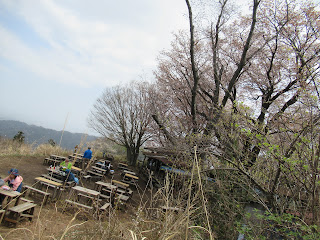So, last January when I still held at hand lots of ripen yuzu fruits, I was searching for the way to store my harvest without using fridge. Oh-so-global-warming-approaches to save food in 2022 … It was difficult to encounter such non-fridge preservation of fresh produce unless sun-drying them completely. Yeah, drying fresh juice of yuzu fruits might be an option for manufacturers … maybe they can make yuzu powder from sour squeeze. I don’t have such nice equipment to perform the magic. I was becoming desperate ... Then, one night I vaguely watched tele. A travelogue by a comedian began. He went into a deep mountain of Yoshino area 吉野, Totsukawa Village 十津川村 of Nara Prefecture 奈良県. People of that community served him lots of local gourmet, like wild herbs, trout, gibier meats … They then gave him a slice of something. He asked, “What is it?” A lady replied with smile. “It’s Yubeshi, an ultimate preserved food. It’s traditional delicacy of our area. It is made of yuzu fruits.” Bingo.
In that tele, the ladies of Yoshino explained there is a legend the food was brought from Kyoto 京都 some 900 years ago by samurai warriors of Heike Clan 平家. Between 1180 and 1185, Japan was in turmoil of civil war. Two big clans of samurai, Genji 源氏 and Heike, crushed for power grab of the nation. In the end, Heike clan was defeated completely. Many soldiers who fought for Heike escaped with their bare life and hid into deep mountains. Yoshino mountains were one of such chosen areas. According to the ladies in the tele, at that time mountain people who gave shelter for Heike survivors noticed the samurais wore formerly-gorgeous but now dirty and blood-stained armour without much provisions. Even though, they dangled few brown balls and bamboo-made water bottle from their waist. Villagers asked what these balls were. The warriors answered they were popular preserved food in fashionable Kyoto, made of yuzu fruits. The country people learned how to make it, and it became Yubeshi, or Yuubeshi. As they were suitable for soldiers to carry, they were like power-bar for athletes some 900 years ago. i.e. They are nutritious, and can be carried at room temperature. IDEAL!!!
 |
| Er, this is Yubeshi, approx. USD 2 for about a dozen bite size. It’s not that we’ll make. For this one, please see below. |
Thanks to electricity-eating method of google search, I could do research for the recipe of Yubeshi. You could do the same, but I have to warn you if you google “Yubeshi, recipe,” you probably found that for sweet rice cake with walnuts, or walnuts and sweet yuzu peels for yuzu fragrance (like here). They are lovely treat by themselves, but not Yubeshi as preserved food. We have to consume rice cake Yubeshi before it becomes hardened, maybe within 2 or 3 days. Yubeshi of Totsukawa can really be stored at room temperature for long, more than 6 months. Another difference between regular Yubeshi and power bar version is their commercial availability. Sweet rice cake Yubeshi can easily be found in supermarkets, like the photo above. They cost 1000 or so yen for large 9 Yubeshi cakes (for online shopping, please check here). For warrior Yubeshi, its price is 1000 or so yen for 1 Yubeshi, i.e. VEEEEERY EXPENSIVE. After checking the recipe you’ll know why it is such a gourmet delicacy … (Hmmmmm … I’ve heard similar food is found in Taiwan, but they sell them at more reasonable price …) Nonperishable Yubeshi is not difficult to make, but it takes time to complete cooking. That’s why I report you my adventure of Yubeshi at the end of March, after harvesting them in January. This week, let’s start from mise en place to make power bar Yubeshi.
 |
| Magic fruits! |
For about 10 yuzu fruits, other ingredients for Yubeshi are
- Miso paste: of whatever of your choice. 250-500g, depends on your taste. Do you remember miso is salty (my post last week)? More miso means saltier Yubeshi.
- Sugar: half or less amount of miso. The choice for the kinds of sugar is totally up to your taste. Using brown sugar, the taste of Yubeshi becomes earthier, but flavor of citrus could be overwhelmed.
- Flour of your choice: wheat or rice, or even soy or almond. You can skip it if you like. I add them in order to retain some carb in the protein-heavy power bar. The amount of flour is the same as the sugar.
- Sake: this is must if you use flour. For 500g of miso, 200cc of sake is a benchmark.
- Mirin: it also is for flour. 500g of miso and 100cc of Mirin would do.
- Sesame seeds: Lots of it, maybe 100cc or more for 10 yuzu fruits. White seeds could give straighter sesame flavor to Yubeshi than black one.
- Walnuts: Chopped for the same amount of sesame. So, for 100cc of sesame, I use 100cc of shopped walnuts.
- Other ingredients could be chopped peanuts. You can replace walnuts with peanuts, or use both.
From these components, don’t you think it will be a powerful power bar? Next week I tell you how to cook them. Please stay tuned!
 |
| I used fine rice flour called Joshinko 上新粉 for my Yubeshi. |
If you find a problem in the greenery of north-half of Yokohama, please make a contact with
Office for the Park Greeneries in the North
北部公園緑地事務所
Yokohama Municipal Government Creative Environment Policy Bureau
横浜市環境創造局
Phone: 045-311-2016
FAX: 045-316-8420




























































